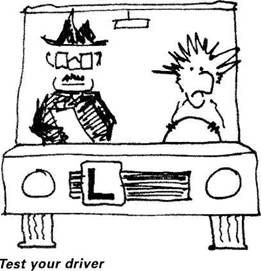Книга: Writing Windows WDM Device Drivers
Driver Tests
Разделы на этой странице:
Driver Tests
This section describes some of the testing issues that are particularly important for device drivers. The following debugging section highlights some of the typical ways that drivers fail. If you — and only you — are writing the user mode program that accesses your driver, you may be able to impose certain constraints on your driver. For example, you could dictate that only one request is ever issued at a time. This would make some of your routines slightly easier to implement. However, it is best to write your routines properly straightaway. It is quite possible for someone to later change the Win32 code without realizing that it might break your driver.

Test That All Functions Work
This may sounds obvious, but check that your driver works. This means writing a test program (or other driver) that exercises all of its functions.
As with any other program, check that all sorts of data work as expected. For example, check that invalid parameters are detected properly. Check that small and large amounts of data can be transferred. Check boundary conditions. For example, if you have a maximum request size of 1024 bytes, check that transfers of 0, 1, 1023, and 1024 bytes succeed and that transfers of 1025 bytes fail.
Check that all the features of the hardware you are driving are exercised. Do you have a strategy for coping with hardware updates? For example, leave some room for more function codes. Make sure that your new hardware firmware can be used by the old driver.
Check that a driver works in stress situations (e.g., in low memory computers or when being pummelled by lots of requests). Do this by repeatedly issuing I/O requests to your driver. Test with other processes doing the same job simultaneously. Another good test is to run your driver while copying a large file to a floppy disk; in Windows 98, this seems to stop most other activities dead in their tracks.
Check that a driver works when more than one of its devices are in use. Check that several user programs or threads can access the driver simultaneously.
Check that your driver works on a clean PC that has never seen your driver. Test on plain vanilla W2000 and W98 systems, without any of the development environment. Check that you installed any recent DLLs that are needed. For example, your user mode installation code may not run with an out-of-date version of SETUPAPI.DLL.
W2000 and W98
Do all your tests in Windows 2000 and Windows 98 if you are writing a driver that runs under both operating systems. If you provide a Dec Alpha W2000 version, check that it works as well.
In particular, check that a driver installs correctly in both operating systems. W2000 and W98 use different locations for some registry entries, though this should not effect most drivers.
Some facilities are only available in NT or W2000. For example, a driver can make calls to write events to the system log. In W98, these functions do nothing. Check that they work properly in NT and Windows 2000.
As long as you use the correct WDM.H header, you should not be making any kernel calls that work only in W2000. For example, I was going to use the ExSystemTimeToLocalTime kernel call in the DebugPrint driver. However, the documentation says that you must include NTDDK.H. This means that the call is not available in W98.
Multiprocessor
If possible, check that your driver works in a multiprocessor computer. Even if you do run it on such a computer, you may have difficulty deciding whether it has passed the test as the time-critical events may not happen very often. Stress testing the driver should force the issue.
Cancelling I/O
Win32 programs can issue asynchronous "overlapped" I/O requests, meaning that they can issue a request and get on with another job while the I/O is happening. Windows 98 programs cannot issue such requests for file I/O, but they can for device I/O.
Initially, there seems to be no difference as far as a device driver is concerned. Both synchronous "blocking" I/O requests and asynchronous I/O requests arrive at the driver in the same way, through the driver dispatch entry points.
However, asynchronous I/O requests can be cancelled. This can happen either when the CancelIo function[13] is called, or if the file handle is closed with the I/O still pending.
Synchronous I/O requests are also cancelled if a process crashes. The operating system tries to cancel any requests and close any open file handles.
How a driver copes with cancelling I/O is covered in a later chapter. Ensure that your test program checks these situations.
- Customizing Default Tests
- Интервью с создателем WebDriver Саймоном Стюартом
- ? Perform Mouse Driver Tests by Using the CETK
- JDBC Туре 4 DRIVER
- Test Driver Code
- Installing Proprietary Video Drivers
- Chapter 8. Device Driver Basics
- 8.1. Device Driver Concepts
- 8.1.2. Device Driver Architecture
- 8.1.3. Minimal Device Driver Example
- 8.1.5. Installing Your Device Driver
- 8.3. Driver Methods




